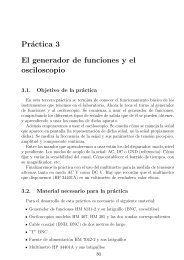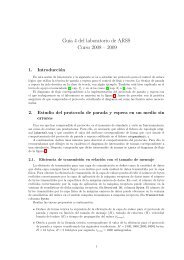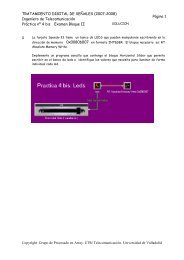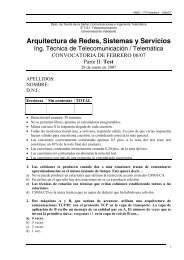Iterative Linear Programming Formulation for Routing and ...
Iterative Linear Programming Formulation for Routing and ...
Iterative Linear Programming Formulation for Routing and ...
Create successful ePaper yourself
Turn your PDF publications into a flip-book with our unique Google optimized e-Paper software.
.CADLogical LinksFig. 2: Logical topology embedded in Fig.1.i) Determine a good virtual topology, that is, theorigin <strong>and</strong> destination node of every lightpath.ii) Route the lightpaths over the physicaltopology.iii) Assign wavelengths to the lightpaths.iv) Route the externally offered traffic on thevirtual topology.In this study, we center in subproblems ii) <strong>and</strong>iii), which are known in joint as the <strong>Routing</strong> <strong>and</strong>Wavelength Assignment (RWA) problem. It can bedefined as follows [2]: Given a network topology <strong>and</strong>a set of lightpath requests, determine a route <strong>and</strong>wavelength(s) <strong>for</strong> the requests. Some parameters to beoptimized when solving the RWA problem are thenumber of wavelengths needed, the wavelength reuse,the physical distance traversed by the traffic, <strong>and</strong> thecost.We propose two separate <strong>for</strong>mulations to solvethe RWA problem when there is no wavelengthconversion. The <strong>for</strong>mer routes the lightpaths in a waythat the average distance traversed per traffic unit isminimized. Besides, it limits the number of lightpathsper fiber link (which is a heuristic <strong>for</strong> limiting thenumber of wavelengths needed). The latter assignswavelengths to the lightpaths once they have beenrouted. In this case, the objective is to maximize thewavelength reuse. We also propose an iterativealgorithm to solve the RWA problem by combiningboth <strong>for</strong>mulations. Finally, a number of results areshowed.The lightpaths are routed using a shortest-pathalgorithm. Then, wavelengths are assigned to thoselightpaths with a large traffic load first.The routing problem is also solved by means of ashortest-path algorithm in [8], but wavelengths areassigned sequentially beginning with the longestlightpath.In [9], subproblem ii) is <strong>for</strong>mulated as an integerlinear programming (ILP) problem. Severaltechniques, as r<strong>and</strong>omized rounding, are employed toreduce the problem complexity. To solve subproblemiii), graph-coloring algorithms are used.A mixed integer linear programming (MILP)<strong>for</strong>mulation <strong>for</strong> subproblems i) <strong>and</strong> ii), as well as anumber of heuristics <strong>for</strong> solving subproblem i) injoint with the RWA problem are proposed in [5].In [10], an ILP <strong>for</strong>mulation <strong>and</strong> two heuristics(based on Dijkstra’s algorithm) are proposed <strong>for</strong>solving RWA. One of them routes lightpathssequentially. The other one routes them in parallel.Both take into account the available wavelengths <strong>and</strong>their capacity at every fiber link. A cost model isstated to compute the distance used by the shortestpathalgorithm. Finally, an improvement step is run.A genetic-algorithm/heuristic hybrid approach isproposed in [11] <strong>for</strong> solving RWA with the objectiveof minimizing the cost of the network.3 <strong>Routing</strong> <strong>and</strong> Wavelength AssignmentAs stated be<strong>for</strong>e, the RWA problem consists inrouting the lightpaths through the physical topology<strong>and</strong> assigning wavelengths to them. We suppose thereis no wavelength conversion, so each lightpath isassigned a single wavelength. In the next paragraphs,we propose new separate ILP <strong>for</strong>mulations <strong>for</strong> solvingsubproblems ii) <strong>and</strong> iii). By separating RWA intosubproblems the total computational cost is reduced.2 Previous WorkIn the last years, several papers about virtualtopology design have been published [4−17]. Next,we will overview some of them concerning therouting <strong>and</strong>/or the wavelength assignment problem.The work in [4] proposes to allocate thewavelengths to the longest lightpaths first, as aheuristic <strong>for</strong> minimizing the number of wavelengthsneeded when solving subproblem iii).In [7], subproblems i), ii) <strong>and</strong> iii) are considered.3.1 The Lightpath <strong>Routing</strong> ProblemIn this problem, a route over the physical topology iscomputed <strong>for</strong> every lightpath. As proposed in [6] <strong>and</strong>[11], we use flow conservation equations at each nodeto properly route the lightpaths. Note that the numberof wavelengths that are needed <strong>for</strong> establishing thelightpaths, once they have been routed, depends onthe maximum number of lightpaths that share a singlefiber link (we call it ρ max ). In fact, ρ max will be a lowerbound on the number of wavelengths. In Fig. 1, the
















